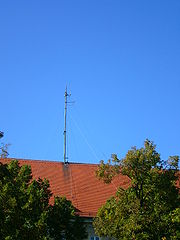
Police radio
Encyclopedia


Law enforcement agency
In North American English, a law enforcement agency is a government agency responsible for the enforcement of the laws.Outside North America, such organizations are called police services. In North America, some of these services are called police while others have other names In North American...
agencies all over the world.
Many such systems are encrypted to prevent eavesdroppers from listening in.
Portable radios
The vast majority of economically developed countries police services have access to such equipment; also, in most countries, police carPolice car
A police car is a ground vehicle used by police, to assist with their duties in patrolling and responding to incidents. Typical uses of a police car include transportation for officers to reach the scene of an incident quickly, to transport criminal suspects, or to patrol an area, while providing a...
s have sets which are designed to receive calls from the control room, and respond. Also, small personal radios exist that allow each officer to carry one easily, as well as a large central room at the Police station
Police station
A police station or station house is a building which serves to accommodate police officers and other members of staff. These buildings often contain offices and accommodation for personnel and vehicles, along with locker rooms, temporary holding cells and interview/interrogation rooms.- Facilities...
which directs personnel to the location of emergency incidents. Portable police radios first appeared within the British police in 1969.
Norway
In Norway, it is legal for private citizens to listen to the police radio, There are even streams available online.United Kingdom
It's legal under the Wireless Telegraphy Act 1949 to listen to police radio in the UK, it being impossible to ban such reception. But it is illegal to "act upon any information" picked up from those transmissions. For example, a journalist cannot go to a crime scene to cover the case if he heard a message on police radio. The move from open analogueAnalog signal
An analog or analogue signal is any continuous signal for which the time varying feature of the signal is a representation of some other time varying quantity, i.e., analogous to another time varying signal. It differs from a digital signal in terms of small fluctuations in the signal which are...
to the encrypted digital
Digital
A digital system is a data technology that uses discrete values. By contrast, non-digital systems use a continuous range of values to represent information...
Airwave system in the UK has made it practically impossible to just listen in to police radio.
Due to recent outbreaks of system down times, the Police and Fire services have emergency back-up radio broadcasting on analogue for threats against the main control centre. The Ambulance Service however has mobile phone systems in place until the system has been updated.
United States
U.S. state patrols, county sheriffs' officesSheriff
A sheriff is in principle a legal official with responsibility for a county. In practice, the specific combination of legal, political, and ceremonial duties of a sheriff varies greatly from country to country....
, and municipal police departments often run their own systems in parallel, presenting interoperability
Interoperability
Interoperability is a property referring to the ability of diverse systems and organizations to work together . The term is often used in a technical systems engineering sense, or alternatively in a broad sense, taking into account social, political, and organizational factors that impact system to...
problems. The FCC assigns licenses to these entities in the public safety (PP and PX) allotments of the spectrum. These include allocations in the lower portion of the VHF spectrum (around 39 - 45 MHz), highly susceptible to "skip" interference but still used by state highway patrols; the VHF "hi-band", from 150 to 160 MHz; and various UHF bands. Many systems still use conventional FM
FM broadcasting
FM broadcasting is a broadcasting technology pioneered by Edwin Howard Armstrong which uses frequency modulation to provide high-fidelity sound over broadcast radio. The term "FM band" describes the "frequency band in which FM is used for broadcasting"...
transmissions for most traffic; others are trunked
Trunking
In modern communications, trunking is a concept by which a communications system can provide network access to many clients by sharing a set of lines or frequencies instead of providing them individually. This is analogous to the structure of a tree with one trunk and many branches. Examples of...
analog or digital systems. Recently, there has been a move towards digital trunked systems, especially those based around the public-safety standard APCO 25 format set by the Association of Public-Safety Communications Officials-International
Association of Public-Safety Communications Officials-International
The Association of Public-Safety Communications Officials-International was founded in 1935 and is the world's largest organization dedicated to public safety telecommunications.APCO has developed several standards that bear its name...
. A minority of other police radio systems, the largest examples being the Milwaukee Police Department and Pennsylvania State Police
Pennsylvania State Police
The Pennsylvania State Police is the state police force of Pennsylvania, responsible for statewide law enforcement. It was founded in 1905 by order of Governor Samuel Pennypacker, in response to the private police forces used by mine and mill owners to stop worker strikes and the inability or...
use the incompatible OpenSky
OpenSky
OpenSky is a registered trademark of Harris Corporation and is the trade name for a wireless communication system, invented by M/A-COM Inc., that is now a division of Harris RF Communications...
format. TETRA
Tetra
thumb|right|250px|Pristella tetra — [[Pristella maxillaris]].thumb|right|250px|Golden Pristella tetra, a [[morph |morph]] of [[Pristella maxillaris]].thumb|right|250px|[[Silvertip tetra]] — Hasemania nana....
, the standard in many European countries as well as other places in the world, is virtually unused in the United States.
Recently, some states have began to operate statewide radio networks with varying levels of participation from police on the county and city levels. Some of them are:
- Illinois: StarCom21StarCom21StarCom21 is a statewide public safety trunked radio system in Illinois. Owned and operated by Motorola, the State of Illinois is a major partner in the system. It is used by all Illinois State Police posts as well as the Illinois State Toll Highway Authority Maintenance and Police...
- Michigan: MPSCS Michigan Public Safety Communications System
- Minnesota: ARMERARMERAllied Radio Matrix for Emergency Response is the 800 MHz trunked public safety radio System used in the State of Minnesota. The system was developed to improve communication amongst emergency services during natural and man made disasters....
http://www.srb.state.mn.us - Montana: Montana Statewide Interoperable Public Safety Radio System http://pssb.mt.gov/siec/default.mcpx
- North Carolina: VIPER http://www.nccrimecontrol.org/Index2.cfm?a=000001,001148
- Ohio: MARCS - Multi-agency communications system
- Wisconsin: WISCOM http://interop.wi.gov/section.asp?linkid=1621&locid=166
It is generally not illegal in the United States to listen to unencrypted police communications. However some states prohibit such listening within vehicles.

